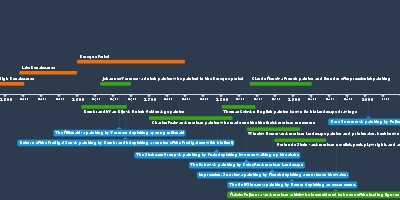CC semester 1 fall timeline WCH
Category: Иное
Обновлено: 11 дек 2021
Авторы

Created byAva Dorsey
Attachments
События
Madonna and Child- A painting drawn by Berlingheiro Berlingheri, influenced many people greatly as a religious iconArnolfini Portrait- A painting created by Jan Van Eyck, very symbolic in form.Mona Lisa- A very world famous painting painted by Leonardo Da Vinci, depicting a mysterious smiling womanSt. Jerome in His Study- an engraving created by Durer, which revolutionized art in his time, and was very symbolic in formsReturn of the Prodigal Son- A painting by Rembrandt, depicting the Biblical tale of the Prodigal son's returnNorman Invasion- invasion and occupation of England led by the Duke of NormandySchool of Athens- a painting created by Raphael, which depicts idealsThe Last Judgement- a painting by Giotto which changed art, using lifelike people instead of iconsПериоды
Berlinghiero Berlinghieri- An artist who lived in the Byzantine period who drew famous pictures of icons.The Middle Ages- the period in European history from the collapse of Roman civilization in the 5th century CE to the period of the RenaissanceJan Van Eyck- An artist in the early Reinassance, inspired by Belinghiero Belinghieri type art, and was one of the first realistic painters.Leonardo Da Vinci- an inventor, painter, draughtsman, engineer, scientist, theorist, sculptor and architect, who painted some of the most famous well known paintingsByzantine Empire- the continuation of the Roman Empire in its eastern provinces during Late Antiquity and the Middle AgesAlbrecht Durer- a German who created revolutionary art technologyJohannes Vermeer- a Dutch Baroque Period painter who specialized in domestic interior scenes of middle-class lifeThe Milkmaid- one of Vermeer's most well known works, depicting a woman pouring milk into a jugRembrandt Van Rijn- a Dutch Golden Age painter, printmaker and draughtsmanAuthoritarian Rome- a form of government that allowed for people to elect officialsJulius Caesar- a Roman general and statesman who was dictator of RomeAmbrose of Milan- a theologian who emphasized true Biblical ChristianityAugustine of Hippo- a philosopher who adapted classical thought to Christian teaching and created a powerful theological system of lasting influenceAmbrogio Lorenzetti- an Italian painter of the Sienese schoolAllegory of Good and Bad Government- a painting created by Ambrogio Lorenzetti, which depicts society with the greatest impunityPope Monarchy in Rome-under Byzantine authority, in practice, Rome became an independent state ruled by the PopeSt. Cyprian- a bishop of Carthrage who had a negative attitude toward classical Greek and Roman learningTertullian- an early Christian author who opposed classical Greek and Roman learningRabbi Gamaliel- was a follower of Paul, and implemented classical learningAquinas- a philosopher who placed divine revelation and human reason on equal footingCharlemagne- king of the franks, who under him, the church worked with society and became a culture forceFrancesco Landini- a foremost Italian musician of the 14th centuryChapel of St. John- a chapel located in the Tower of LondonWinchester Cathedral- the Cathedral Church of the Holy TrinityDurham Cathedral- a cathedral in the city of Durham, EnglandEarly Gothic Period-the style of architecture that appeared in northern France, Normandy and then EnglandLate Gothic Period- the most elaborate architectural experiment that took place in southern Germany and AustriaArnolfo- a gothic style artist who began the cathedral in FlorenceAbbey of St. Denis- an abbey that started the gothic style movementAristotle- a Greek philosopher and polymath who founded the Lyceum, the Peripatetic school of philosophy, and the Aristotelian traditionRaphael-an Italian painter and architect of the High RenaissanceJohn Wycliffe- an English philosopher who created an English translation of the Bible, and taught that the Bible was supreme authorityJohn Huss- a Czech theologian who agreed that man must return to God only through the work of ChristGiotto- an Italian painter who changed Florentine paintingDante- a writer who wrote the way Giotto paintedThe Divine Comedy- an Italian narrative poem by DantePetrarch-a scholar seen as "the father of nee humanism"Salutati- a Florentine Chancellor, who was very humanistic in his ideologyBruni-a Florentine Chancellor who was also very humanistic in his viewsBrunelleschi- an achitect, who shifted emphasis from gothic art back to classicalMasaccio- the father of Renaissance painting, one of the first to compine prespective and light, with his people standing firmly on the groundJosquin Dez Prez- a French composer of the Renaissance, who was called a tone painterOttaviano Pertrucci- the first printer of musicMarsilio Ficino- an Italian philosopher who taught neo-platonic thinkingMartin Luther-a German professor of theology, priest, author, composer, former Augustinian monk, and is best known as a seminal figure in the Protestant Reformation
Comments